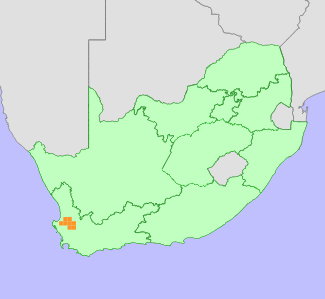|
Scientific Name | Babiana inclinata Goldblatt & J.C.Manning |
Higher Classification | Monocotyledons |
Family | IRIDACEAE |
National Status |
Status and Criteria | Endangered B1ab(iii)+2ab(iii) |
Assessment Date | 2021/04/30 |
Assessor(s) | L. von Staden & D. Raimondo |
Justification | This species has an extent of occurrence (EOO) of 2 016 km², and an area of occupancy (AOO) of 136 km². It is restricted to an area that is severely transformed by wheat cultivation. It occurs in severely fragmented subpopulations which remain in small, isolated habitat remnants, mainly along roadsides. These fragments are continually being degraded due to the effects of fragmentation, which includes too infrequent fires, alien plant invasion and loss of specialist pollinators. It is therefore listed as Endangered under criteria B. |
Distribution |
Endemism | South African endemic |
Provincial distribution | Western Cape |
Range | An endemic species to South Africa, that is restricted to the southwestern corner of the Western Cape. It extends from Porterville and Gouda to Piketberg and Hopefield. |
Habitat and Ecology |
Major system | Terrestrial |
Major habitats | Swartland Shale Renosterveld, Swartland Silcrete Renosterveld |
Description | It is found in Swartland Shale Renosterveld, occurring on damp clay flats and lower slopes. |
Threats |
| Swartland Shale Renosterveld within the known range of this species is 95% transformed by agriculture (calculated using GIS) and has been classified as a Critically Endangered vegetation type. This species however does not qualify for listing under the A criterion due to the relatively short generation time in relation to the long history (± 150 years) of land transformation in the Western Cape. This formerly common species is now reduced to small subpopulations restricted to small fragments and occurs mainly in highly threatened roadside reserves, which are being continually degraded by too infrequent fire and alien invasive encroachment. |
Population |
There is not much known about the overall population size of this species. However, where specimen and iNaturalist observation records include notes on populations size, these have all be noted to be small less than 50 individuals. Furthermore, the majority of subpopulations occur on small isolated remnants of vegetation. The population is therefore considered severely fragmented. Population decline is ongoing as a result of habitat transformation and degradation to crop cultivation.
|
Population trend | Decreasing |
Conservation |
| No known extant sites protected within reserves. |
Assessment History |
Taxon assessed |
Status and Criteria |
Citation/Red List version | | Babiana inclinata Goldblatt & J.C.Manning | EN B1ab(iii)+2ab(iii) | Raimondo et al. (2009) | |
Bibliography |
Goldblatt, P. and Manning, J.C. 2007. A revision of the southern African genus Babiana, Iridaceae, Crocoideae. Strelitzia 18:1-97. South African National Biodiversity Institute, Pretoria.
Goldblatt, P. and Manning, J.C. 2020. Iridaceae of southern Africa. Strelitzia 42. South African National Biodiversity Institute, Pretoria.
Raimondo, D., von Staden, L., Foden, W., Victor, J.E., Helme, N.A., Turner, R.C., Kamundi, D.A. and Manyama, P.A. 2009. Red List of South African Plants. Strelitzia 25. South African National Biodiversity Institute, Pretoria.
Rouget, M., Reyers, B., Jonas, Z., Desmet, P., Driver, A., Maze, K., Egoh, B. and Cowling, R.M. 2004. South African National Spatial Biodiversity Assessment 2004: Technical Report. Volume 1: Terrestrial component. South African National Biodiversity Institute, Pretoria.
|
Citation |
| von Staden, L. & Raimondo, D. 2021. Babiana inclinata Goldblatt & J.C.Manning. National Assessment: Red List of South African Plants version . Accessed on 2025/07/31 |
 Comment on this assessment
Comment on this assessment


